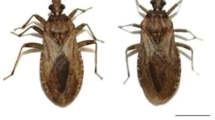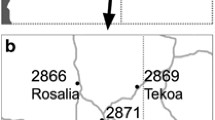Abstract
A comparison of chiasma distribution patterns between two chromosomal taxa, Moreton and Torresian, and their F1 hybrids demonstrates highly significant differences between all chromosomes analysed. In chromosomes 1, 2, 4, 5, 6 and 8 these differences can be directly attributed to pericentric heterozygosity in the F1 hybrid. In chromosomes 7 and 8 where there is no pericentric heterozygosity these differences may be due to heterozygosity for interstitial and terminal bands of hetero-chromatin or possibly undetected paracentric rearrangements. The F1 hybrids also have a significantly lower mean cell chiasma frequency. The Moreton and Torresian taxa differ significantly in chiasma distribution pattern in chromosomes 1, 2, 4, 5, 6 and 8 and both Moreton populations analysed have a significantly lower mean cell chiasma frequency than the Torresian population. In addition the two Moreton populations, (MMX) and (MAX), differ significantly in the chiasma distribution pattern in chromosomes 1 and 2 and the chromosomally more polymorphic population (MMX) has a significantly lower mean cell chiasma frequency. There is some evidence that the differences in both chiasma distribution and frequency between these two populations may be due to genetic differences in addition to the effects caused by chromosomal polymorphism. It has been shown that in general there is a substantial reduction in recombination in the intersitial regions of most chromosomes in the Moreton and particularly the Torresian taxon because of a proximal-distal localisation of chiasmata. In the F1 hybrid, however, nearly all recombination events are located within these interstitial regions. This provides support for the hypothesis that the frequent placement of chiasmata in regions of normally low recombination may disrupt the internal coadapted genetic environment of both chromosomal forms resulting in non-functional recombinant progeny in the next generation. The recombination data in this study also provide a basis for an empirical test of this hypothesis.
Similar content being viewed by others
References
Ashley, T., Moses, M.J., Solari, A.J.: Electron microscopy analysis of a pericentric inversion in the sand rate (Psammomys obesus). Genetics 91 (suppl), 52–53 (1979)
Brncic, D.: Heterosis and the integration of the genotype in geographic populations of Drosophila pseudoobscura. Genetics 39, 77–88 (1954)
Carson, H.L.: The genetics of speciation at the diploid level. Am. Nat. 109, 83–92 (1975)
Craig-Cameron, T., Jones, C.H.: The analysis of exchanges in tritium labelled meiotic chromosomes. I. Schistocerca gregaria. Heredity 25, 223–232 (1970)
Dobzhansky, T.: Genetics of natural populations. XIX. Origin of heterosis through natural selection in populations of Drosophila pseudoobscura. Genetics 35, 288–302 (1950)
Dobzhansky, T.: Genetics of the evolutionary process. Columbia University Press (1970)
Fletcher, H.L., Hewitt, G.M.: Non-homologous synaptonemal complex formation in a hetero-morphic bivalent in Keyacris scurra (Morabinae, Orthoptera). Chromosoma (Berl.) 65, 271–281 (1978)
Fox, D.P.: The control of chiasma distribution in the locust, Schistocerca gregaria (Forskål) Chromosoma (Berl.) 43, 289–328 (1973)
Franklin, I., Lewontin, R.C.: Is the gene the unit of selection? Genetics 65, 707–734 (1970)
Gibbon, J.D.: Nonparametric statistical inference New York: McGraw-Hill 1971
Hedrick, P., Jain, S., Holden, L.: Multilocus systems in evolution. Evol. Biol. 11, 101–184
Henderson, S.A.: Chiasma distribution at diplotene in a locust. Heredity 18, 173–190 (1963)
Hewitt, G.M.: An interchange which raises chiasma frequency. Chromosoma (Berl.) 21, 285–295 (1967)
John, B.: The cytogenetic systems of grasshoppers and locusts. II. The origin and evolution of supernumerary segments. Chromosoma (Berl.) 44, 123–146 (1973)
John, B.: Heterochromatin variation in natural populations. Chromosomes Today 7, 128–137 (1981)
John, B., Lewis, K.R.: The Meiotic System. Protoplasmatologia VIF1. Wien-New York: Springer, 1965
Jones, G.H.: The analysis of exchange in tritium-labelled meiotic chromosomes. II. Stethophyma grossum. Chromosoma (Berl.) 34, 367–382 (1971)
Martin, J.: Meiosis in inversion heterozygotes in Chironomidae. Can. J. Genet. Cytol. 9, 255–268 (1967)
Mather, K.: Genetical structure of populations. London: Chapman and Hall 1973
Maynard-Smith, J.: The Evolution of sex. Cambridge: Cambridge University Press 1978
Moran, C.: The structure of the hybrid zone in Caledia captiva. Heredity 42, 13–32 (1979)
Moran, C.: Spermatogenesis in natural and experimental hybrids between chromosomally differentiated taxa of Caledia captiva. Chromosoma (Berl.) 81, 579–591 (1981)
Moran, C., Shaw, D.D.: Population cytogenetics of the genus Caledia (Orthoptera: Acridinae). III. Chromosomal polymorphism, racial parapatry and introgression. Chromosoma (Berl.) 63, 181–204 (1977)
Moran, C., Wilkinson, P., Shaw, D.D.: Allozyme variation across a narrow hybrid zone in the grasshopper Caledia captiva. Heredity 44, 69–81 (1980)
Peacock, W.J.: Replication, recombination and chiasmata in Goniaea australasiae (Orthoptera: Acrididae). Genetics 65, 593–617 (1970)
Rees, H., Dale, P.J.: Chiasmata and variability in Lolium and Festuca populations. Chromosoma (Berl.) 47, 335–351 (1974)
Shaw, D.D.: Population cytogenetics of the genus Caledia (Orthoptera: Acridinae). I. Inter- and intraspecific karyotype diversity. Chromosoma (Berl.) 54, 221–243 (1976)
Shaw, D.D., Knowles, G.R.: Comparative chiasma analysis using a computerised optical digitiser. Chromosoma (Berl.) 59, 103–127 (1976)
Shaw, D.D., Wilkinson, P.: Chromosome differentiation, hybrid breakdown and the maintenance of a narrow hybrid zone in Caledia. Chromosoma (Berl.) 80, 1–31 (1980)
Shaw, D.D., Webb, G.C., Wilkinson, P.: Population cytogenetics of the genus Caledia (Orthoptera: Acridinae). II. Variation in the pattern of C-banding. Chromosoma (Berl.) 56, 169–190 (1976)
Shaw, D.D., Wilkinson, P., Coates, D.J.: The chromosomal component of reproductive isolation in the grasshopper Caledia captiva; IL The relative viabilities of recombinant and non-recombinant chromosomes during embryogenesis. Chromosoma (Berl.) 86, 533–549 (1982)
Southern, D.I.: Chiasma distribution in Truxaline grasshoppers. Chromosoma (Berl.) 22, 164–191 (1967)
Tease, C., Jones, G.H.: Analysis of exchanges in differentially stained meiotic chromosomes of Locusta migratoria after BrdU-substitution and FPG staining. I. Crossover exchanges in monochiasmate bivalents. Chromosoma (Berl.) 69, 163–178 (1978)
Turner, J.R.G.: Why does the genotype not congeal? Evolution (Lawrence, Kans.) 21, 645–656 (1967)
Vetukhiv, M.: Integration of the genotype in local populations of three species of Drosophila. Evolution (Lawrence, Kans.) 8, 241–251 (1954)
Wallace, B.: On coadaptation in Drosophila. Am. Nat. 87, 343–358 (1953)
Webb, G.C.: Chromosome organisation in the Australian plague locust, Chortoicetes terminifera. I. Banding relationships of the normal and supernumerary chromosomes. Chromosoma (Berl.) 55, 229–246 (1976)
Whitehouse, C., Edgar, L.A., Jones, G.H., Parker, J.S.: The population cytogenetics of Crepis capillaris. I. Chiasma variation. Heredity 47, 95–103 (1981)
Weissman, D.B.: Geographical variability in the pericentric inversion system of the grasshopper Trimerotropis pseudofasciata. Chromosoma (Berl.) 55, 325–347 (1976)
White, M.J.D., Morley, F.H.W.: Effects of pericentric rearrangements on recombination in grasshopper chromosomes. Genetics 40, 604–619 (1955)
Author information
Authors and Affiliations
Rights and permissions
About this article
Cite this article
Coates, D.J., Shaw, D.D. The chromosomal component of reproductive isolation in the grasshopper Caledia captiva . Chromosoma 86, 509–531 (1982). https://doi.org/10.1007/BF00330124
Received:
Issue Date:
DOI: https://doi.org/10.1007/BF00330124




